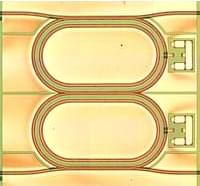Cosmic rays may have given right-handed genetic helixes an evolutionary edge at the beginning of life’s history.


Share on Facebook: http://on.fb.me/13K5GUw.
What if you could fax someone a real, three-dimensional object? The solution might come in the form of programmable matter — a material that takes on predetermined shapes and can change its configuration on demand. We’re already seeing early prototypes coming from Carnegie Mellon and Intel in the form of “claytronics.” So what’s in store for this technology, and why should we be excited about it?
If you had a vat of claytronic atoms in front of you, what’s the first thing you’d build with it? Let us know in the comments below!
https://www.youtube.com/subscription_center?add_user=fwthinking.
For the audio podcast, blog and more, visit the Fw: Thinking website:
http://www.fwthinking.com.
Fw: Thinking on Twitter: http://www.twitter.com/fwthinking.
MIT scientists are building ElectroVoxels, small, smart, self-assembling robots designed for space.
It’s programmable matter, infinitely recyclable large-scale 3D printing, if you will, and it could be the future of robotics and machinery in space. In this TechFirst, I chat with MIT PhD student Martin Nisser.

Serious Science — http://serious-science.org.
Neuroscientist Neil Burgess on the discovery of place cells, spatial memory, and experiments with functional neuroimaging.
In order to build a future able to stretch across millions of years, we may need to be able to build machines able to endure the brutal erosion of deep time.
Visit https://brilliant.org/isaacarthur/ to get started learning STEM for free, and the first 200 people will get 20% off their annual premium subscription.
Join this channel to get access to perks:
/ @isaacarthursfia.
Visit our Website: http://www.isaacarthur.net.
Join Nebula: https://go.nebula.tv/isaacarthur.
Support us on Patreon: / isaacarthur.
Support us on Subscribestar: https://www.subscribestar.com/isaac-a… Group: / 1,583,992,725,237,264 Reddit:
/ isaacarthur Twitter:
/ isaac_a_arthur on Twitter and RT our future content. SFIA Discord Server:
/ discord Credits: The Million Year Machine Science & Futurism with Isaac Arthur Episode 333; March 10, 2022 Produced, Written, and Narrated by Isaac Arthur Editors: Jason Burbank Cover Art: Jakub Grygier https://www.artstation.com/jakub_grygier Graphics: Darth Biomech Jeremy Jozwik https://www.artstation.com/zeuxis_of_… Ken York of YD Visual
/ ydvisual Legiontech Studios Sergio Botero https://www.artstation.com/sboterod?f… Udo Schroeter Music by: Markus Junnikkala https://markusjunnikkala.com Stellardrone: https://stellardrone.bandcamp.com/
Facebook Group: / 1583992725237264
Reddit: / isaacarthur.
Twitter: / isaac_a_arthur on Twitter and RT our future content.
SFIA Discord Server: / discord.
Credits:
The Million Year Machine.
Science & Futurism with Isaac Arthur.
Episode 333; March 10, 2022
Produced, Written, and Narrated by Isaac Arthur.
Editors:
Jason Burbank.
Cover Art:
Jakub Grygier https://www.artstation.com/jakub_grygier.
Graphics:
Darth Biomech.
Jeremy Jozwik https://www.artstation.com/zeuxis_of_…
Ken York of YD Visual / ydvisual.
Legiontech Studios.
Sergio Botero https://www.artstation.com/sboterod?f…
Udo Schroeter.
Music by:
The Kardashev Scale measures how powerful a high-tech civilization is, with K-1 indicating a advanced society able to call on all the power of their planet, which we often envision as a Post-Scarcity Utopia. Is this the future of Humanity? And if so, how can we achieve it?
Start listening with a 30-day Audible trial and your first audiobook is free. Visit.
http://www.audible.com/isaac or text \.
In the future technology may help us enjoy prosperity beyond our dreams, with robots manufacturing our goods and attending all our needs but one… our need for purpose.
The first 1,000 people to use the link will get a free trial of Skillshare Premium Membership: https://skl.sh/isaacarthur04211
Check out Jerry’s story \.
This week, we bring you a Tale by one of the lesser known greats of 1950s science fiction, Frederik Pohl. \.
How Human Consciousness Evolved.
Watch the newest video from Big Think: https://bigth.ink/NewVideo.
Join Big Think Edge for exclusive videos: https://bigth.ink/Edge.
Daniel C. Dennett is the author of Intuition Pumps and Other Tools for Thinking, Breaking the Spell, Freedom Evolves, and Darwin’s Dangerous Idea and is University Professor and Austin B. Fletcher Professor of Philosophy, and Co-Director of the Center for Cognitive Studies at Tufts University. He lives with his wife in North Andover, Massachusetts, and has a daughter, a son, and a grandson. He was born in Boston in 1942, the son of a historian by the same name, and received his B.A. in philosophy from Harvard in 1963. He then went to Oxford to work with Gilbert Ryle, under whose supervision he completed the D.Phil. in philosophy in 1965. He taught at U.C. Irvine from 1965 to 1971, when he moved to Tufts, where he has taught ever since, aside from periods visiting at Harvard, Pittsburgh, Oxford, and the École Normale Supérieure in Paris.
His first book, Content and Consciousness, appeared in 1969, followed by Brainstorms (1978), Elbow Room (1984), The Intentional Stance (1987), Consciousness Explained (1991), Darwin’s Dangerous Idea (1995), Kinds of Minds (1996), and Brainchildren: A Collection of Essays 1984–1996. Sweet Dreams: Philosophical Obstacles to a Science of Consciousness, was published in 2005. He co-edited The Mind’s I with Douglas Hofstadter in 1981 and he is the author of over three hundred scholarly articles on various aspects on the mind, published in journals ranging from Artificial Intelligence and Behavioral and Brain Sciences to Poetics Today and the Journal of Aesthetics and Art Criticism.
Dennett gave the John Locke Lectures at Oxford in 1983, the Gavin David Young Lectures at Adelaide, Australia, in 1985, and the Tanner Lecture at Michigan in 1986, among many others. He has received two Guggenheim Fellowships, a Fulbright Fellowship, and a Fellowship at the Center for Advanced Studies in Behavioral Science. He was elected to the American Academy of Arts and Sciences in 1987.
He was the Co-founder (in 1985) and Co-director of the Curricular Software Studio at Tufts, and has helped to design museum exhibits on computers for the Smithsonian Institution, the Museum of Science in Boston, and the Computer Museum in Boston.
DANIEL DENNETT: